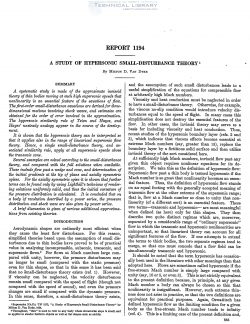naca-report-1194
- Version
- 194 Downloads
- 2.32 MB File Size
- 1 File Count
- November 2, 2016 Create Date
- November 2, 2016 Last Updated
National Advisory Committee for Aeronautics, Report - A Study of Hypersonic Small Disturbance Theory

A systematic study is made of the approximate inviscid
theory of thin bodies moving at such high supersonic speeds that
nonlinearity is an essential feature of the equations of flow.
The first-order smallrdisturbance equations are derived for three-
dimensional motions involving shock waves, and estimates are
obtained for the order of error involved in the approximation.
The hypersonic similarity rule of Tsien and Hayes, and
Hayes’ unsteady analogy appear in the course of the develop—
ment.
It is shown that the hypersonic theory can be interpreted so
that it applies also in the range of linearized supersonic flow
theory. Hence, a single small-disturbance theory, and as-
sociated similarity rule, apply at all supersonic speeds above
the transonic zone.
Several examples are solved according to the small-disturbance
theory, and compared with the full solutions when available.
These include flow past a wedge and cone, and determination of
the initial gradients at the tip of plane and axially symmetric
ogives. For the axially symmetric ogive it is shown that further
terms can be found only by using Lighthill’s technique of render-
ing solutions uniformly valid, and thus the initial curvature of
the pressure distribution is calculated. It is concluded that on
a body bf revolution described by a power series, the pressure
distribution and shock wave are also given by power series.
A brief discussion is given of various additional approxima-
tions from misting theories.
Aerodynamic shapes are ordinarily most efficient when
they cause the least flow disturbance. For this reason,
simplified theories based upon the assumption of small dis—
turbances due to thin bodies have proved to be of practical
value in analyzing incompressible, subsonic, transonic, and
supersonic flows.2 For flows at Mach numbers large com—
pared with unity, however, the pressure disturbances may
no longer be small (compared with the static pressure)
even for thin shapes, so that in this sense it has been said
that no ”small-disturbance theory exists (ref. 1). However,
if viscosity can be neglected, the velocity disturbances
remain small compared with the speed of flight (though not
compared with the speed of sound), and even the pressure
changes are small if compared with the dynamic pressure.
| File | Action |
|---|---|
| naca-report-1194 A Study of Hypersonic Small Disturbance Theory.pdf | Download |

Comment On This Post